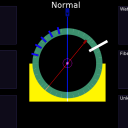Index of refraction
From Algodoo
Index of refraction
| Language: | English |
|---|---|
| Description: | This lesson is designed to help students visualize the idea of indexes of refraction by comparing how much light bends with various indexes of refraction. It also gives students hands on practice without using Snell’s’ Law. |
| Target: | Key Stage 4, Key Stage 5 |
| Category: | Laboratory |
| Discipline: | Optics |
| Learning objectives: |
|
| In class: | Show students an example of light bending causing a distorted image (an object in water will work). Challenge the students to explain why this happens. If need be, introduce the idea of indexes of refraction.
Based on their answers, ask them to picture a laser traveling from air into water at an odd angle. Will it bend towards or away from the normal? What if the laser went from water to air? same path? What if the index of refraction of the water was increases from 1.33 to 1.5 or 1.8? How would this affect the path that the light travels? As a class, discuss each of the above questions and have students record their predictions in each scenario. Once students have made predictions, engage the following activity. |
Steps in Algodoo
CREATE A SCENE
Open the ‘Index of refraction’ scene above.
MAKE A PREDICTION
If students have not done so already, make predictions about how the bending of light will change with different indexes of refraction.
RUN/INTERACT
There are six clear blocks made of different materials. Four of the six have their printed index of refraction on the block. Starting with the water block, place it so that it covers the bottom half of the circle (it should perfectly fit over the yellow block). Using the green protractor, position the laser at 15°, 30°, 45°, 60°, and 75° (marked by the blue ticks) and record what angle the laser ‘bends’ to. Repeat this process for the other five blocks.
EVALUATE
Based on your data, did the light bend towards or away from the normal? Is there any pattern between how much the light bent and the index of refraction? Can you see any pattern in how much the light bent? Make a prediction of what the indexes of refraction are for the two unknown boxes.
REVISE SCENE
Repeat the above process except place the clear block on the upper half of the circle instead of the bottom half.
MAKE A PREDICTION
Make a prediction of how you think this will affect your data. the light to bend more or less? Will it bend towards or away from the normal?
RUN/INTERACT
Spin the laser to the different intervals and record your results.




